2016 Hyundai Elantra fold seats
[x] Cancel search: fold seatsPage 20 of 498
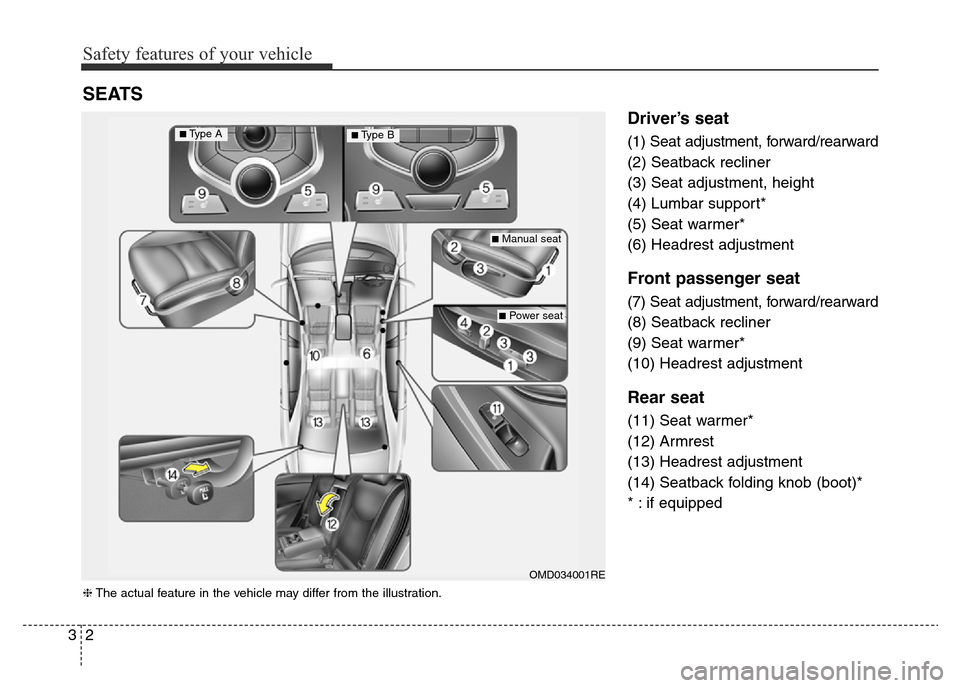
Safety features of your vehicle
2 3
Driver’s seat
(1) Seat adjustment, forward/rearward
(2) Seatback recliner
(3) Seat adjustment, height
(4) Lumbar support*
(5) Seat warmer*
(6) Headrest adjustment
Front passenger seat
(7) Seat adjustment, forward/rearward
(8) Seatback recliner
(9) Seat warmer*
(10) Headrest adjustment
Rear seat
(11) Seat warmer*
(12) Armrest
(13) Headrest adjustment
(14) Seatback folding knob (boot)*
* : if equipped
SEATS
❈The actual feature in the vehicle may differ from the illustration.
OMD034001RE
■Manual seat
■Power seat
■Type A■Type B
Page 22 of 498
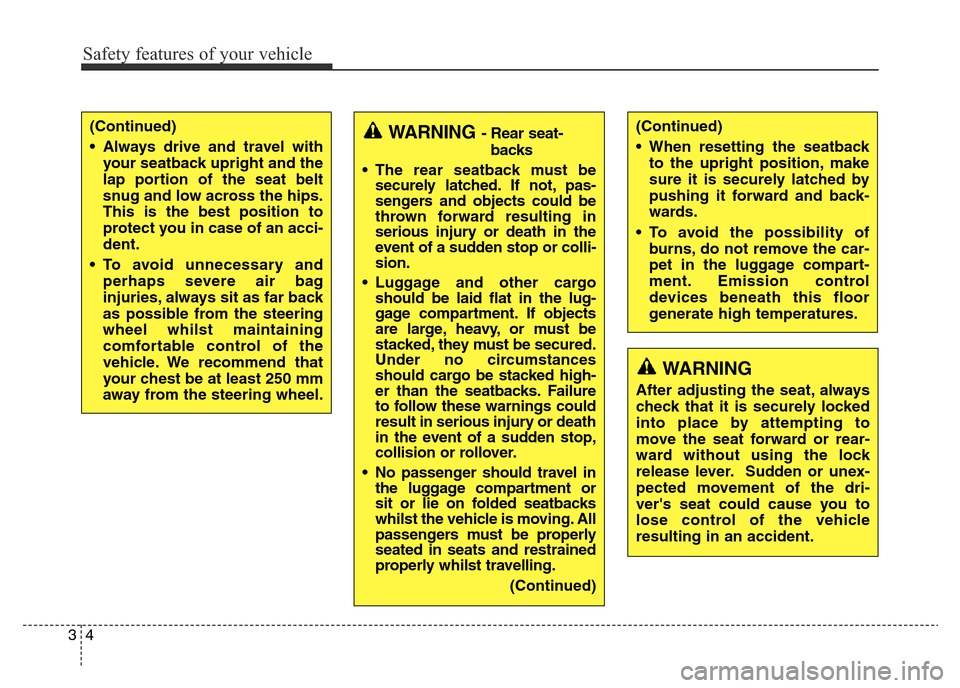
Safety features of your vehicle
4 3
(Continued)
• Always drive and travel with
your seatback upright and the
lap portion of the seat belt
snug and low across the hips.
This is the best position to
protect you in case of an acci-
dent.
• To avoid unnecessary and
perhaps severe air bag
injuries, always sit as far back
as possible from the steering
wheel whilst maintaining
comfortable control of the
vehicle. We recommend that
your chest be at least 250 mm
away from the steering wheel.WARNING- Rear seat-
backs
• The rear seatback must be
securely latched. If not, pas-
sengers and objects could be
thrown forward resulting in
serious injury or death in the
event of a sudden stop or colli-
sion.
• Luggage and other cargo
should be laid flat in the lug-
gage compartment. If objects
are large, heavy, or must be
stacked, they must be secured.
Under no circumstances
should cargo be stacked high-
er than the seatbacks. Failure
to follow these warnings could
result in serious injury or death
in the event of a sudden stop,
collision or rollover.
• No passenger should travel in
the luggage compartment or
sit or lie on folded seatbacks
whilst the vehicle is moving. All
passengers must be properly
seated in seats and restrained
properly whilst travelling.
(Continued)(Continued)
• When resetting the seatback
to the upright position, make
sure it is securely latched by
pushing it forward and back-
wards.
• To avoid the possibility of
burns, do not remove the car-
pet in the luggage compart-
ment. Emission control
devices beneath this floor
generate high temperatures.
WARNING
After adjusting the seat, always
check that it is securely locked
into place by attempting to
move the seat forward or rear-
ward without using the lock
release lever. Sudden or unex-
pected movement of the dri-
ver's seat could cause you to
lose control of the vehicle
resulting in an accident.
Page 35 of 498
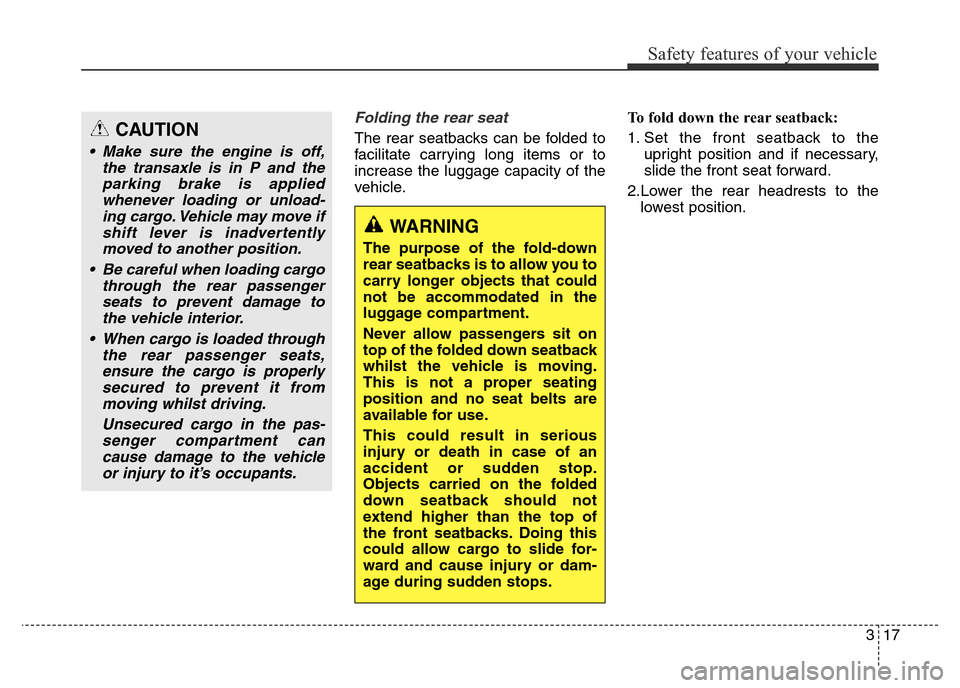
317
Safety features of your vehicle
Folding the rear seat
The rear seatbacks can be folded to
facilitate carrying long items or to
increase the luggage capacity of the
vehicle.To fold down the rear seatback:
1. Set the front seatback to the
upright position and if necessary,
slide the front seat forward.
2.Lower the rear headrests to the
lowest position.CAUTION
• Make sure the engine is off,
the transaxle is in P and the
parking brake is applied
whenever loading or unload-
ing cargo. Vehicle may move if
shift lever is inadvertently
moved to another position.
• Be careful when loading cargo
through the rear passenger
seats to prevent damage to
the vehicle interior.
• When cargo is loaded through
the rear passenger seats,
ensure the cargo is properly
secured to prevent it from
moving whilst driving.
Unsecured cargo in the pas-
senger compartment can
cause damage to the vehicle
or injury to it’s occupants.
WARNING
The purpose of the fold-down
rear seatbacks is to allow you to
carry longer objects that could
not be accommodated in the
luggage compartment.
Never allow passengers sit on
top of the folded down seatback
whilst the vehicle is moving.
This is not a proper seating
position and no seat belts are
available for use.
This could result in serious
injury or death in case of an
accident or sudden stop.
Objects carried on the folded
down seatback should not
extend higher than the top of
the front seatbacks. Doing this
could allow cargo to slide for-
ward and cause injury or dam-
age during sudden stops.
Page 37 of 498
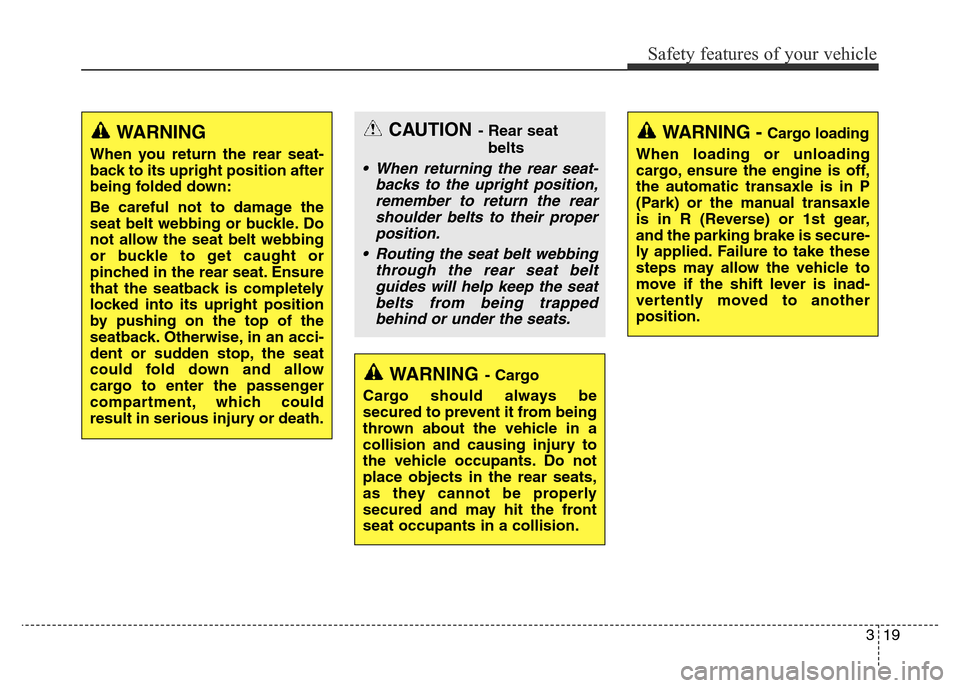
319
Safety features of your vehicle
WARNING- Cargo
Cargo should always be
secured to prevent it from being
thrown about the vehicle in a
collision and causing injury to
the vehicle occupants. Do not
place objects in the rear seats,
as they cannot be properly
secured and may hit the front
seat occupants in a collision.
WARNING - Cargo loading
When loading or unloading
cargo, ensure the engine is off,
the automatic transaxle is in P
(Park) or the manual transaxle
is in R (Reverse) or 1st gear,
and the parking brake is secure-
ly applied. Failure to take these
steps may allow the vehicle to
move if the shift lever is inad-
vertently moved to another
position.WARNING
When you return the rear seat-
back to its upright position after
being folded down:
Be careful not to damage the
seat belt webbing or buckle. Do
not allow the seat belt webbing
or buckle to get caught or
pinched in the rear seat. Ensure
that the seatback is completely
locked into its upright position
by pushing on the top of the
seatback. Otherwise, in an acci-
dent or sudden stop, the seat
could fold down and allow
cargo to enter the passenger
compartment, which could
result in serious injury or death.
CAUTION- Rear seat
belts
• When returning the rear seat-
backs to the upright position,
remember to return the rear
shoulder belts to their proper
position.
• Routing the seat belt webbing
through the rear seat belt
guides will help keep the seat
belts from being trapped
behind or under the seats.
Page 49 of 498
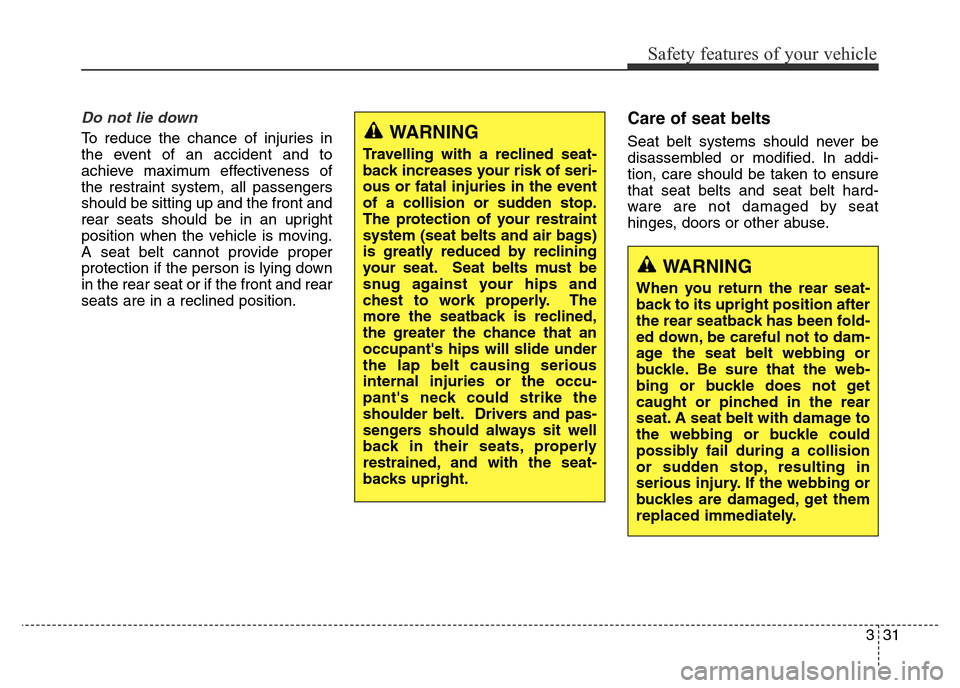
331
Safety features of your vehicle
Do not lie down
To reduce the chance of injuries in
the event of an accident and to
achieve maximum effectiveness of
the restraint system, all passengers
should be sitting up and the front and
rear seats should be in an upright
position when the vehicle is moving.
A seat belt cannot provide proper
protection if the person is lying down
in the rear seat or if the front and rear
seats are in a reclined position.
Care of seat belts
Seat belt systems should never be
disassembled or modified. In addi-
tion, care should be taken to ensure
that seat belts and seat belt hard-
ware are not damaged by seat
hinges, doors or other abuse.WARNING
Travelling with a reclined seat-
back increases your risk of seri-
ous or fatal injuries in the event
of a collision or sudden stop.
The protection of your restraint
system (seat belts and air bags)
is greatly reduced by reclining
your seat. Seat belts must be
snug against your hips and
chest to work properly. The
more the seatback is reclined,
the greater the chance that an
occupant's hips will slide under
the lap belt causing serious
internal injuries or the occu-
pant's neck could strike the
shoulder belt. Drivers and pas-
sengers should always sit well
back in their seats, properly
restrained, and with the seat-
backs upright.
WARNING
When you return the rear seat-
back to its upright position after
the rear seatback has been fold-
ed down, be careful not to dam-
age the seat belt webbing or
buckle. Be sure that the web-
bing or buckle does not get
caught or pinched in the rear
seat. A seat belt with damage to
the webbing or buckle could
possibly fail during a collision
or sudden stop, resulting in
serious injury. If the webbing or
buckles are damaged, get them
replaced immediately.
Page 79 of 498
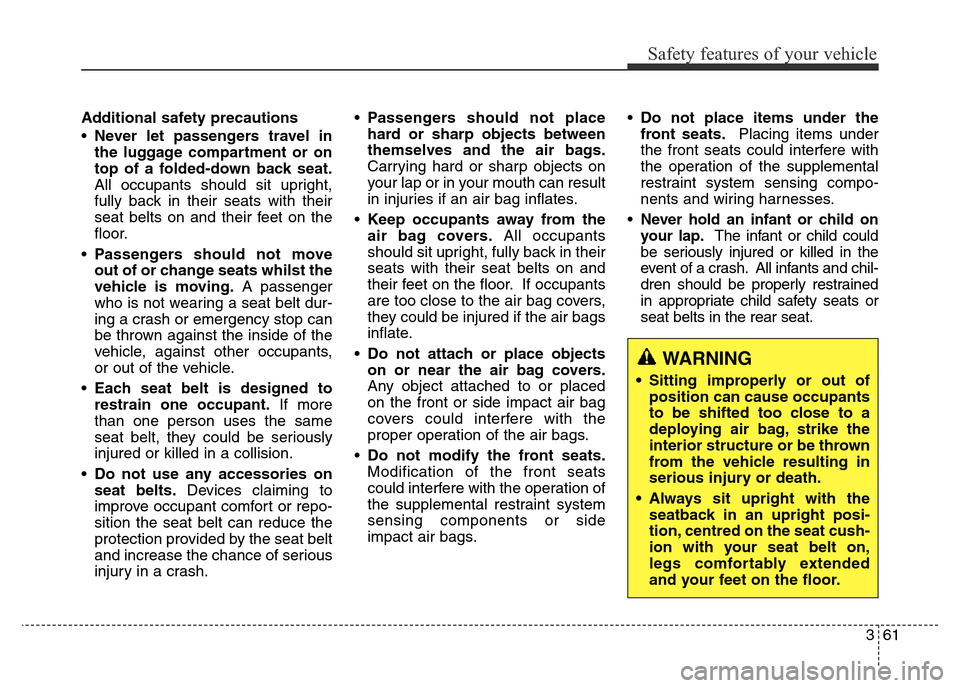
361
Safety features of your vehicle
Additional safety precautions
•Never let passengers travel in
the luggage compartment or on
top of a folded-down back seat.
All occupants should sit upright,
fully back in their seats with their
seat belts on and their feet on the
floor.
•Passengers should not move
out of or change seats whilst the
vehicle is moving.A passenger
who is not wearing a seat belt dur-
ing a crash or emergency stop can
be thrown against the inside of the
vehicle, against other occupants,
or out of the vehicle.
•Each seat belt is designed to
restrain one occupant.If more
than one person uses the same
seat belt, they could be seriously
injured or killed in a collision.
•Do not use any accessories on
seat belts.Devices claiming to
improve occupant comfort or repo-
sition the seat belt can reduce the
protection provided by the seat belt
and increase the chance of serious
injury in a crash.•Passengers should not place
hard or sharp objects between
themselves and the air bags.
Carrying hard or sharp objects on
your lap or in your mouth can result
in injuries if an air bag inflates.
•Keep occupants away from the
air bag covers.All occupants
should sit upright, fully back in their
seats with their seat belts on and
their feet on the floor. If occupants
are too close to the air bag covers,
they could be injured if the air bags
inflate.
•Do not attach or place objects
on or near the air bag covers.
Any object attached to or placed
on the front or side impact air bag
covers could interfere with the
proper operation of the air bags.
•Do not modify the front seats.
Modification of the front seats
could interfere with the operation of
the supplemental restraint system
sensing components or side
impact air bags.•Do not place items under the
front seats.Placing items under
the front seats could interfere with
the operation of the supplemental
restraint system sensing compo-
nents and wiring harnesses.
•Never hold an infant or child on
your lap.The infant or child could
be seriously injured or killed in the
event of a crash. All infants and chil-
dren should be properly restrained
in appropriate child safety seats or
seat belts in the rear seat.
WARNING
• Sitting improperly or out of
position can cause occupants
to be shifted too close to a
deploying air bag, strike the
interior structure or be thrown
from the vehicle resulting in
serious injury or death.
• Always sit upright with the
seatback in an upright posi-
tion, centred on the seat cush-
ion with your seat belt on,
legs comfortably extended
and your feet on the floor.